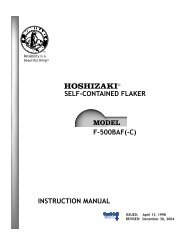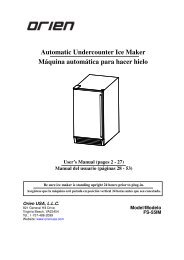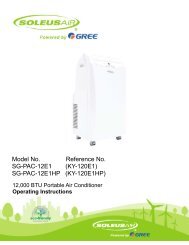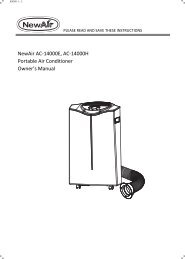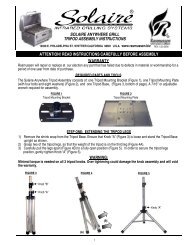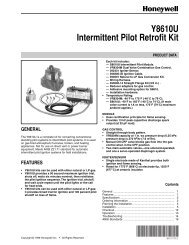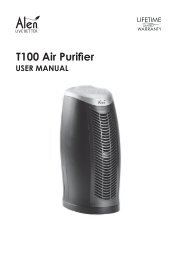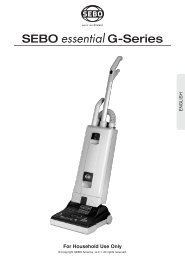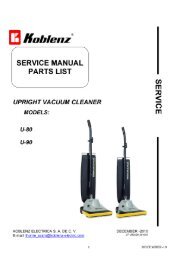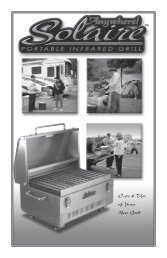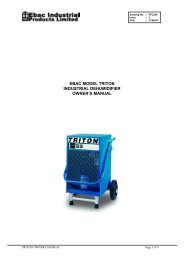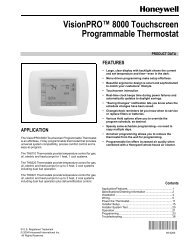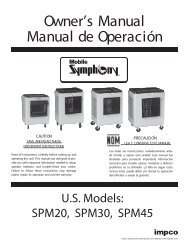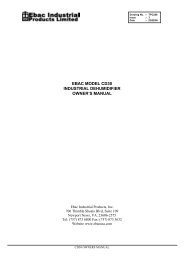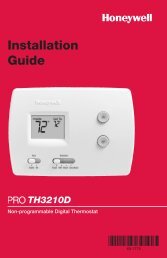BP7453-1 Luxe Eco Ceiling Fan - Emerson Fans
BP7453-1 Luxe Eco Ceiling Fan - Emerson Fans
BP7453-1 Luxe Eco Ceiling Fan - Emerson Fans
Create successful ePaper yourself
Turn your PDF publications into a flip-book with our unique Google optimized e-Paper software.
Your new ceiling fan will require a grounded electrical<br />
supply line of 120 volts AC, 60 Hz, 15 amp circuit.<br />
The outlet box must be securely anchored and<br />
capable of withstanding a load of at least 50 pounds.<br />
!<br />
To reduce the risk of fire, electrical shock, or<br />
personal injury, mount fan to outlet box marked<br />
“Acceptable for <strong>Fan</strong> Support of 22.7 kg. (50 lbs.) or<br />
less”, and use screws supplied with outlet box. Most<br />
outlet boxes commonly used for support of light<br />
fixtures are not acceptable for fan support and may<br />
need to be replaced. Consult a qualified electrician if<br />
in doubt.<br />
If your fan is to replace an existing ceiling light fixture,<br />
turn electricity off at the main fuse box at this time and<br />
remove the existing light fixture.<br />
Electrical Requirements<br />
WARNING<br />
4<br />
!<br />
WARNING<br />
Turning off wall switch is not sufficient. To avoid<br />
possible electrical shock, be sure electricity is<br />
turned off at the main fuse box before wiring. All<br />
wiring must be in accordance with National and<br />
Local codes and the ceiling fan must be properly<br />
grounded as a precaution against possible electrical<br />
shock.<br />
!<br />
WARNING<br />
To avoid fire or shock, follow all wiring instructions<br />
carefully. Any electrical work not described in these<br />
instructions should be done or approved by a<br />
licensed electrician.<br />
How to Put Your <strong>Ceiling</strong> <strong>Fan</strong> Together<br />
1. Remove the hanger ball by loosening the setscrew<br />
in the hanger ball until the ball falls freely down the<br />
downrod (Figure 3). Remove the pin from the<br />
downrod, then remove the hanger ball. Retain the<br />
pin and hanger ball for reinstallation in Step 5.<br />
2. Loosen setscrews in motor coupling. Separate,<br />
untwist and unkink the two 80” motor leads. Route<br />
the motor lead wires through the downrod. Insert<br />
the downrod into the motor coupling. Align the<br />
clevis pin holes in the downrod with the holes in the<br />
motor coupling. Install the clevis pin and secure<br />
with the hairpin clip (Figure 1). The clevis pin must<br />
go through the holes in the motor coupling and the<br />
holes in the downrod. Be sure to push the straight<br />
leg of the hairpin clip through the hole near the end<br />
of the clevis pin until the curved portion of the<br />
hairpin clip snaps around the clevis pin. The hairpin<br />
clip must be properly installed to prevent the clevis<br />
pin from working loose. Pull on the downrod to<br />
make sure the clevis pin is properly installed.<br />
3. While pulling up on the downrod, securely tighten<br />
the two setscrews in the motor coupling (Figure 2).<br />
NOTE: The setscrews must be properly installed<br />
as described above, or fan wobble could result.<br />
!<br />
WARNING<br />
It is critical that the clevis pin in the motor coupling<br />
is properly installed and the setscrews securely<br />
tightened. Failure to verify that the pin and setscrews<br />
are properly installed could result in the fan falling.<br />
Figure 1<br />
SETSCREW SETSCREW (2)<br />
CLEVIS CLEVIS PIN PIN<br />
Figure 2<br />
PIN<br />
HANGER<br />
BALL<br />
DOWNROD<br />
SETSCREW<br />
DOWNROD<br />
HAIRPIN<br />
CLIP<br />
MOTOR<br />
COUPLING MOTOR<br />
COUPLING<br />
ETL Model No.: CF550



